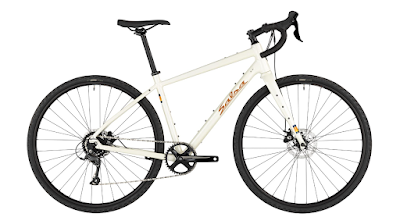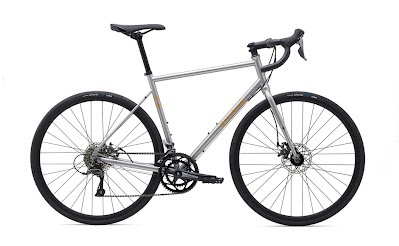Cycling is an activity that has seen a surge in popularity over the past few years, and it's easy to see why. Not only is it an excellent form of exercise, but it's also a great way to explore new places and take in the sights and sounds of the great outdoors. However, with so many different types of bikes available, it can be tough to know which one to choose. Today we'll take a look at why you should consider purchasing a gravel bike and list the Best gravel bikes under $1,000.
The Best Gravel Bikes Under $1,000.
- State 4130 All-Road
- Diamondback Haanjo 2
- Surly Preamble
- Salsa Journeyer Advent
- Marin Nicasio
Gravel bikes, also known as adventure bikes, are designed to handle a variety of different terrains, including dirt roads, gravel paths, and even single-track trails. They are typically characterized by wider tires, a more relaxed geometry, and a durable frame that can withstand the rigors of off-road riding. Here are some reasons why you should consider buying a gravel bike:
Versatility: Gravel bikes are incredibly versatile and can be used for a wide range of activities. Whether you want to explore new trails, commute to work, or tackle a long-distance bikepacking trip, a gravel bike can handle it all. With their wider tires and comfortable geometry, they are perfect for both on and off-road riding.
Comfort: One of the main benefits of a gravel bike is the comfort it provides. The wider tires and relaxed geometry make for a more comfortable ride, which is especially important when you're spending hours in the saddle. This makes them an excellent choice for anyone looking to do longer rides or multi-day tours.
Durability: Gravel bikes are built to withstand the rigors of off-road riding. They typically have a more durable frame and components, which means they can handle rough terrain and challenging conditions. This makes them a great investment for anyone looking for a bike that will last for years to come.
Adventure: Gravel bikes are designed for adventure. They allow you to explore new places and take on new challenges, whether it's a long-distance bikepacking trip or a weekend camping excursion. They provide a sense of freedom and adventure that you just don't get with other types of bikes.
Fun: Perhaps the most important reason to buy a gravel bike is that they are just plain fun to ride. Whether you're cruising down a dirt road or tackling a technical single-track trail, a gravel bike provides a sense of excitement and adventure that is hard to beat.
The Best Gravel Bikes Under $1,000.
State 4130 All-Road
The 4130 All-Road is State Bicycles most capable bike ever! With the choice of 650B or 700C wheels, the rugged chromoly steel frame and forks feature plenty of cargo mounts, an 11-speed drivetrain, and disc-brakes.
If you have a little extra to spend, State offers several upgrades including carbon fiber forks, Selle Italia or Brooks saddles, tubeless wheels, racks, and handlebar bags. The listed price of $899.99 is a tremendous bargain.
Diamondback Haanjo 2
Most of us don't have room for all the bikes we desire. The Diamondback Haanjo 2 can fill the role of multiple bikes at once. Want to take a long road trip on a touring bike? The Haanjo 2 has mounts for dront and rear racks to carry all your gear. Need a fast, reliable bike for commuting? Fender mounts will help keep yu clean and dry. Looking for off-pavement fun? The Haanjo 2 features grippy 700x38 tires to handle dirt and gravel with ease. The Diamondback Haanjo 2 is a steal at $925.00.
Surly Preamble
The challenge was to build a serious steel bike, keep it simple, and give it only the attributes that mattered most. It had to be quick and comfortable riding on pavement, but stable and confidence inspiring when handling dirt or gravel. Surly's answer to the challenge is the Preamble.
Available in drop-bar and flat bar configurations the Surly Preamble has mounts for racks, fenders, and water bottles. The simple 12-42t, 1x8 drivetrain minimizes the chances for problems while the disc brakes ensure stopping power. Priced at $899.00, the Surly Preamble eliminates all excuses for not owning a gravel bike.
Salsa Journeyer Advent
The Journeyer Advent is a gravel adventure bike that fills the needs or novice or experienced cyclists. The aluminum frame and fork provides relaxed geometry for a great ride on city streets or tough gravel roads. Three-pack mounts on the fork, top-tube and accessory mounts, provide a perfect platform for long gravel days, commuting, or bikepacking excursions.
Available with 650B or 700C wheels and a 1x9 drivetrain, the Salsa Journeyer Advent can be yours for just $999.
Marin Nicasio
The Marin Nicasio is built around a smooth-riding and stylish CrMo frame and fork with 700C wheels and room for 35mm tires. The Nicasio comes complete with a 2x8 speed Shimano Claris drivetrain, mechanical disc brakes, and fender and rack mounts.
Whether you're interested in adventure road, off-road, or long distance commuting the Marin Nicasio will get you where you're headed at the low price of $899.00.
A gravel bike is an excellent investment for anyone looking for a versatile, comfortable, and durable bike that can handle a variety of different terrains. Whether you're a seasoned cyclist or just getting started, a gravel bike is sure to provide you with hours of fun and adventure. So why not consider buying one today?

















